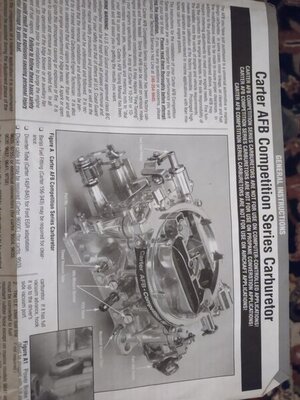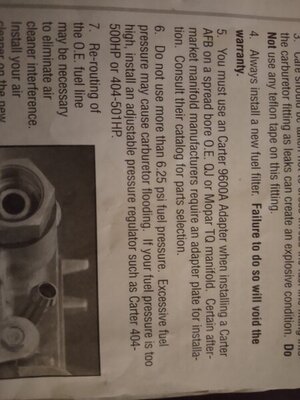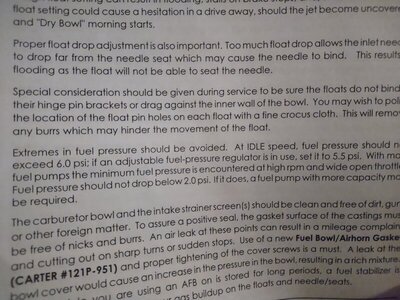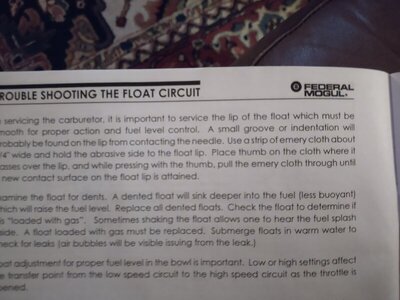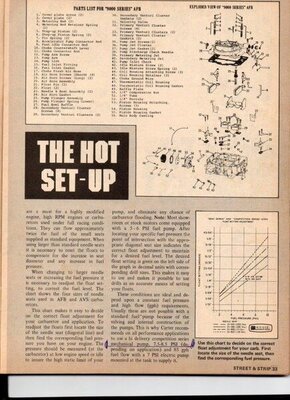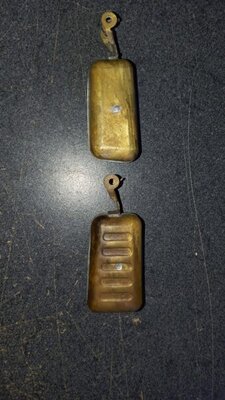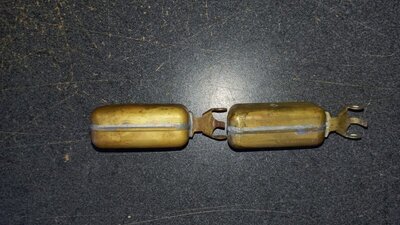Geoff 2
Well-Known Member
FMA,
There is some misinformation creeping in here.
[1] Carter/Edel carbs can withstand a LOT more fuel pressure than brand H & clones [ before flooding ] because of the superior leverage ratio of the float system.
[2] Edel carbs that I have seen come with 0.0935" n/seats. From my 1980 Carter catolog under n/seats: 'The two smaller sizes 0.0935 & 0.1015 are std equipment in most AFB, AVS & TQ carbs'. The #3705 came from the factory with 0.1015" n/seats.
[3] The fuel pressure quote in post #15 looks like an Edel quote. I have personally run pressures as high as 10-12 psi at the track as a means of slightly enrichening the mixture; not a hint of flooding. The 1963 426 2 by 4 bbl fuel pressure is listed as 6-8 psi in my Motors Manual.
[4] I would NOT lower the FP below 6psi, that is not the problem. Adding a regulator to a pump system that already has an inbuilt regulator is only going to load the pump more, more likely to cause pressure fluctuations & early pump failure.
[5] Ign timing at idle is mooooooooooooost important with low vac cams & needs to be sorted BEFORE touching the carb. This is a most misunderstood topic, even among experienced engine builders. I saw a YT video recently, cannot remember the name, but the bloke said: Unless you are using 35* minimum at idle, you are not doing it right; he 'gets it'......
Chrysler got it wrong by not using manifold sourced vac adv [ MVA ]. Instead, they used the useless PVA. GM used MVA on high compression, short duration cams. Their cars left showroom floors idling with 24-26* BTDC!!!!!! And you have only 18* with a low vac cam!!!!! You will need a lot more. Test is really simple: engine warmed up, idling, turn dist slowly until you get the highest rpm. Toggle dist to make sure highest rpm has been reached. Now check what the timing is & that is what the engine needs as the initial timing. My GTO idles with 48*. You can use a locked dist, programmable 'box' or adj vac adv dist [ see link below ]
to get the reqd timing. Say your test shows 40*. You can keep the original 18* & use MVA to add the 22*. Most adj VA units allow up to 30* of timing. Screw the Allen Key fully CW [ lowest vac setting ].
Here is quote from D. Vizard, author of 30+ auto books. Note this is about idle timing, but is in a carb book: ' The optimum idle advance is typically 35-40* for a short cammed street engine & [ though not commonly realized] as much as 50* for a street/strip engine ]'.
[6] Once the timing has been sorted [ you can just leave the dist at the reqd timing as a temporary measure ], you can dial in the idle cct. Increasing timing will increase idle rpm [ because the engine is making more HP...& vacuum...with the timing it needs ]. You can now reset the t/blade position. I doubt whether it will be enough close of enough of the t slot, so some extra idle air is probably going to be needed.
[7] Adding idle air. If the carbs still have vel valves in the secondary, I would NOT crack open the secs. AFBs are an ingeniously designed carb & have an ingenious low speed enrichment cct in the sec boosters. These might be activated if the blades are open, causing more fuel flow, the problem you are trying to fix.
[8] The pri blades are alum. Any holes in them can be soldered shut with alum solder & a sol iron [ not the flame type ]. I would drill a 1/16" hole in all 4 pri blades & go from there for bypass air; enlarge in 1/64" increments until you have 0.010-0.040" of T slot showing, less is better. If the mixture screws are many turns out, then you should enlarge the IFR in the pri boosters. Start with a 0.002" increase.
[9] All of the above is tedious work but the reward will be worth it....
MVA, scroll down to post #6.
www.hotrodders.com/forum/vacuum-advance-hooked-up-directly-manifold-bad-47495.html
There is some misinformation creeping in here.
[1] Carter/Edel carbs can withstand a LOT more fuel pressure than brand H & clones [ before flooding ] because of the superior leverage ratio of the float system.
[2] Edel carbs that I have seen come with 0.0935" n/seats. From my 1980 Carter catolog under n/seats: 'The two smaller sizes 0.0935 & 0.1015 are std equipment in most AFB, AVS & TQ carbs'. The #3705 came from the factory with 0.1015" n/seats.
[3] The fuel pressure quote in post #15 looks like an Edel quote. I have personally run pressures as high as 10-12 psi at the track as a means of slightly enrichening the mixture; not a hint of flooding. The 1963 426 2 by 4 bbl fuel pressure is listed as 6-8 psi in my Motors Manual.
[4] I would NOT lower the FP below 6psi, that is not the problem. Adding a regulator to a pump system that already has an inbuilt regulator is only going to load the pump more, more likely to cause pressure fluctuations & early pump failure.
[5] Ign timing at idle is mooooooooooooost important with low vac cams & needs to be sorted BEFORE touching the carb. This is a most misunderstood topic, even among experienced engine builders. I saw a YT video recently, cannot remember the name, but the bloke said: Unless you are using 35* minimum at idle, you are not doing it right; he 'gets it'......
Chrysler got it wrong by not using manifold sourced vac adv [ MVA ]. Instead, they used the useless PVA. GM used MVA on high compression, short duration cams. Their cars left showroom floors idling with 24-26* BTDC!!!!!! And you have only 18* with a low vac cam!!!!! You will need a lot more. Test is really simple: engine warmed up, idling, turn dist slowly until you get the highest rpm. Toggle dist to make sure highest rpm has been reached. Now check what the timing is & that is what the engine needs as the initial timing. My GTO idles with 48*. You can use a locked dist, programmable 'box' or adj vac adv dist [ see link below ]
to get the reqd timing. Say your test shows 40*. You can keep the original 18* & use MVA to add the 22*. Most adj VA units allow up to 30* of timing. Screw the Allen Key fully CW [ lowest vac setting ].
Here is quote from D. Vizard, author of 30+ auto books. Note this is about idle timing, but is in a carb book: ' The optimum idle advance is typically 35-40* for a short cammed street engine & [ though not commonly realized] as much as 50* for a street/strip engine ]'.
[6] Once the timing has been sorted [ you can just leave the dist at the reqd timing as a temporary measure ], you can dial in the idle cct. Increasing timing will increase idle rpm [ because the engine is making more HP...& vacuum...with the timing it needs ]. You can now reset the t/blade position. I doubt whether it will be enough close of enough of the t slot, so some extra idle air is probably going to be needed.
[7] Adding idle air. If the carbs still have vel valves in the secondary, I would NOT crack open the secs. AFBs are an ingeniously designed carb & have an ingenious low speed enrichment cct in the sec boosters. These might be activated if the blades are open, causing more fuel flow, the problem you are trying to fix.
[8] The pri blades are alum. Any holes in them can be soldered shut with alum solder & a sol iron [ not the flame type ]. I would drill a 1/16" hole in all 4 pri blades & go from there for bypass air; enlarge in 1/64" increments until you have 0.010-0.040" of T slot showing, less is better. If the mixture screws are many turns out, then you should enlarge the IFR in the pri boosters. Start with a 0.002" increase.
[9] All of the above is tedious work but the reward will be worth it....
MVA, scroll down to post #6.
www.hotrodders.com/forum/vacuum-advance-hooked-up-directly-manifold-bad-47495.html

